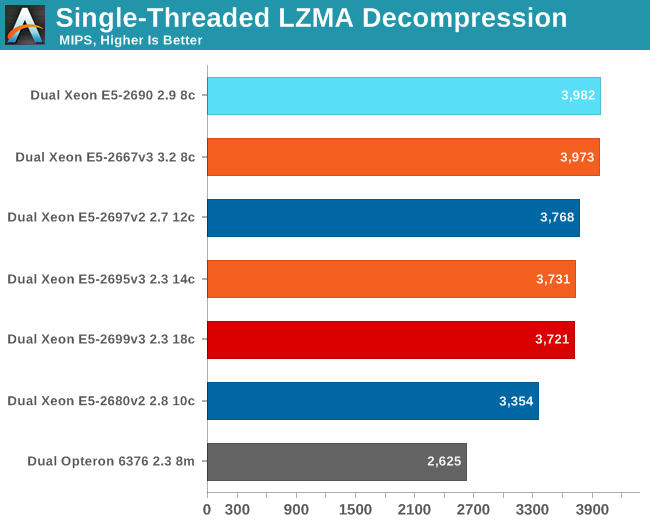Intel Xeon E5 Version 3: Up to 18 Haswell EP Cores
by Johan De Gelas on September 8, 2014 12:30 PM ESTSingle-Threaded Integer Performance
I admit, the following two benchmarks are almost irrelevant for anyone buying a Xeon E5 based machine. But still, we have to quench our curiosity: how much have the new cores been improved? There is a lot that can be said about the sophisticated "uncore" improvements (cache coherency policies, low latency rings, and so on) that allow this multi-core monster to scale, but at the end of the day, good performance starts with a good core. And since we have listed the many subtle core improvements, we could not resist the opportunity to see how each core compares.
The results aren't totally meaningless either, as the profile of a compression algorithm is somewhat similar to many server workloads: it can be hard to extract instruction level parallelism (ILP) and it's sensitive to memory parallelism and latency. The instruction mix is a bit different, but it's still somewhat similar to many server workloads. And as one more reason to test performance in this manner, the 7-zip source code is available under the GNU LGPL license. That allows us to recompile the source code on every machine with the -O2 optimization with gcc 4.8.1.

It looks more boring than it is. First of all, judging by the reactions on forums, many people expected that an 18-core E5-2699 v3 at 2.3GHz would be slower than a 3.2GHz Xeon E5-2667 v3. However you actually can have it all. The Xeon E5-2699 v3 and 2695 v3 boost their clock speed to no less than 3.6GHz when only one or two cores are active. The Xeon E5-2667 v3's maximum Turbo Boost is also the same 3.6GHz, so when only a few threads are active, the Xeon E5-2667 v3 has no clock advantage over the "mega/expensive SKUs" other than the fact that the clock speed will not drop lower than 3.2GHz if all cores are running at full bore.
Despite the fact that the Xeon E5-2690 core has lower IPC, it is able to keep up as it can boost the standard clock speed from 2.9 to 3.8GHz. As it is very hard to extract more IPC out of this kind of code, the extra 200MHz is enough to keep up.
Let's see how the chips compare in decompression. Decompression is an even lower IPC (Instructions Per Clock) workload, as it is very branch intensive and depends on the latencies of the multiply and shift instructions.

The older Xeon E5 takes the lead as decompression runs at very low IPC and is mostly depended on clock speed and low latency accesses. The new Xeon E5 v3 has slightly higher latency in both L3 cache and memory, so it falls behind.
What makes this benchmark interesting is that it proves that Turbo Boost works very well, even on an 18-core chip with a massive die. This is a big bonus, as especially in situations where you are setting up/preparing a system to be productive, it is very likely that you will be waiting for some single-threaded application to end. It also means that if one heavy request hits the server while it is running at very low load, the response time of the request will be low, keeping the impatient users happy.










85 Comments
View All Comments
coburn_c - Monday, September 8, 2014 - link
MY God - It's full of transistors!Samus - Monday, September 8, 2014 - link
I wish there were socket 1150 Xeon's in this class. If I could replace my quad core with an Octacore...wireframed - Saturday, September 20, 2014 - link
If you can afford an 8-core CPU, I'm sure you can afford a S2011 board - it's like 15% of the price of the CPU, so the cost relative to the rest of the platform is negligible. :)Also, s1150 is dual-channel only. With that many cores, you'll want more bandwidth.
peevee - Wednesday, March 25, 2015 - link
For many, if not most workloads it will be faster to run 4 fast (4GHz) cores on 4 fast memory channels (DDR4-2400+) than 8 slow (2-3GHz) cores on 2 memory channels. Of course, if your workload consists of a lot of trigonometry (sine/cosine etc), or thread worksets completely fit into 2nd level cache (only 256k!), you may benefit from 8/2 config. But if you have one of those, I am eager to hear what it is.tech6 - Monday, September 8, 2014 - link
The 18 core SKU is great news for those trying to increase data center density. It should allow VM hosts with 512Gb+ of memory to operate efficiently even under demanding workloads. Given the new DDR4 memory bandwidth gains I wonder if the 18 core dual socket SKUs will make quad socket servers a niche product?Kevin G - Monday, September 8, 2014 - link
In fairness, quad socket was already a niche market.That and there will be quad socket version of these chips: E5-4600v3's.
wallysb01 - Monday, September 8, 2014 - link
My lord. My thought is that this really shows that v3 isn’t the slouch many thought it would be. An added 2 cores over v2 in the same price range and turbo boosting that appears to functioning a little better, plus the clock for clock improvements and move to DDR4 make for a nice step up when all combined.I’m surprised Intel went with an 18 core monster, but holy S&%T, if they can squeeze it in and make it function, why not.
Samus - Monday, September 8, 2014 - link
I feel for AMD, this just shows how far ahead Intel is :\Thermogenic - Monday, September 8, 2014 - link
Intel isn't just ahead - they've already won.olderkid - Monday, September 8, 2014 - link
AMD saw Intel behind them and they wondered how Intel fell so far back. But really Intel was just lapping them.